Design and Implementation of a Planar MIMO Antenna for Spectrum-Sensing Applications
Abstract
:1. Introduction
2. Related Works
- The bandwidth ratio of the suggested antenna is significantly high when compared to the reported antenna structures.
- The SWB antenna designs proposed in the open literature featured one or two notched bands, whereas the suggested SWB antenna has three notched bands.
- The three notches in the SWB are achieved without using any filters, which streamlines the antenna development procedure.
- The suggested SWB antenna occupies relatively little space and may be readily incorporated into compact-size RF equipment.
3. Antenna Configuration
3.1. Design of SWB SESC Antenna Element with Triple-Band Notches
Design Methodology
3.2. Design of SWB SESC Quad-Element MIMO Antenna with Three-Band Notches
4. Results and Discussion
5. Conclusions
Author Contributions
Funding
Data Availability Statement
Acknowledgments
Conflicts of Interest
References
- Lin, Z.; Lin, M.; Champagne, B.; Zhu, W.-P.; Al-Dhahir, N. Secrecy-Energy Efficient Hybrid Beamforming for Satellite-Terrestrial Integrated Networks. IEEE Trans. Commun. 2021, 69, 6345–6360. [Google Scholar] [CrossRef]
- Lin, Z.; Niu, H.; An, K.; Wang, Y.; Zheng, G.; Chatzinotas, S.; Hu, Y. Refracting RIS-Aided Hybrid Satellite-Terrestrial Relay Networks: Joint Beamforming Design and Optimization. IEEE Trans. Aerosp. Electron. Syst. 2022, 58, 3717–3724. [Google Scholar] [CrossRef]
- Xue, Q.; Liu, Y.-J.; Sun, Y.; Wang, J.; Yan, L.; Feng, G.; Ma, S. Beam Management in Ultra-Dense mmWave Network via Federated Reinforcement Learning: An Intelligent and Secure Approach. IEEE Trans. Cogn. Commun. Netw. 2023, 9, 185–197. [Google Scholar] [CrossRef]
- An, K.; Lin, M.; Ouyang, J.; Zhu, W.-P. Secure Transmission in Cognitive Satellite Terrestrial Networks. IEEE J. Sel. Areas Commun. 2016, 34, 3025–3037. [Google Scholar] [CrossRef]
- Rumsey, V. Frequency Independent Antennas; Academic Press: New York, NY, USA, 1996; ISBN 9781483282220. [Google Scholar]
- Khandelwal, M.K.; Kumar, S.; Kanaujia, B.K. Design, modeling and analysis of dual-feed defected ground microstrip patch antenna with wide axial ratio bandwidth. J. Comput. Electron. 2018, 17, 1019–1028. [Google Scholar] [CrossRef]
- Pan, S.; Lin, M.; Xu, M.; Zhu, S.; Bian, L.-A.; Li, G. A Low-Profile Programmable Beam Scanning Holographic Array Antenna Without Phase Shifters. IEEE Internet Things J. 2022, 9, 8838–8851. [Google Scholar] [CrossRef]
- Khandelwal, M.K.; Kanaujia, B.K.; Dwari, S.; Kumar, S.; Gautam, A.K. Triple band circularly polarized compact microstrip antenna with defected ground structure for wireless applications. Int. J. Microw. Wirel. Technol. 2016, 8, 943–953. [Google Scholar] [CrossRef]
- Kumar, S.; Lee, G.H.; Kim, D.H.; Haunan, N.S.; Choi, H.C.; Kim, K.W. Compact Planar Super-Wideband Monopole Antenna with Four Notched Bands. Electronics 2020, 9, 1204. [Google Scholar] [CrossRef]
- Balani, W.; Sarvagya, M.; Samasgikar, A.; Ali, T.; Kumar, P. Design and Analysis of Super Wideband Antenna for Microwave Applications. Sensors 2021, 21, 477. [Google Scholar] [CrossRef]
- Kodavanti, P.V.; Jayasree, P.V.Y.; Bhima, P.R. Design and analysis of super wide band antenna and its notch band characteristics. Soft Comput. 2022, 26, 4275–4287. [Google Scholar] [CrossRef]
- Rohaninezhad, M.; Asadabadi, M.J.; Ghobadi, C.; Nourinia, J. Design and fabrication of a super-wideband transparent antenna implanted on a solar cell substrate. Sci. Rep. 2023, 13, 9977. [Google Scholar] [CrossRef] [PubMed]
- Sharma, V.; Gunaram; Deegwal, J.K.; Mathur, D. Super-Wideband Compact Offset Elliptical Ring Patch Antenna for 5G Applications. Wirel. Pers. Commun. 2022, 122, 1655–1670. [Google Scholar] [CrossRef]
- Paul, L.C.; Islam, M. A Super Wideband Directional Compact Vivaldi Antenna for Lower 5G and Satellite Applications. Int. J. Antennas Propag. 2021, 2021, 8933103. [Google Scholar] [CrossRef]
- Mandal, S.; Mandal, S.K.; Mal, A.K.; Mahapatra, R. Design of a super-wideband on-chip antenna with improved characteristics using bulk micromachining. Microsyst. Technol. 2022, 28, 937–946. [Google Scholar] [CrossRef]
- Mushiake, Y. A report on Japanese development of antennas: From the Yagi-Uda antenna to self-complementary antennas. IEEE Antennas Propag. Mag. 2004, 46, 47–60. [Google Scholar] [CrossRef]
- Mushiake, Y. Self-complementary antennas. IEEE Antennas Propag. Mag. 1992, 34, 23–29. [Google Scholar] [CrossRef]
- Xu, P.; Fujimoto, K.; Lin, S. Performance of quasi-self-complementary antenna using a monopole and a slot. In Proceedings of the IEEE Antennas and Propagation Society International Symposium (IEEE Cat. No.02CH37313), San Antonio, TX, USA, 16-–21 June 2002. [Google Scholar] [CrossRef]
- Guo, L.; Wang, S.; Gao, Y.; Wang, Z.; Chen, X.; Parini, C. Study of printed quasi-self-complementary antenna for ultra-wideband systems. Electron. Lett. 2008, 44, 511–512. [Google Scholar] [CrossRef] [Green Version]
- Guo, L.; Wang, S.; Chen, X.; Parini, C. Study of compact antenna for UWB applications. Electron. Lett. 2010, 46, 115–116. [Google Scholar] [CrossRef]
- Lin, C.-C.; Huang, C.-Y.; Su, J.-Y. Ultra-wideband quasi-self-complementary antenna with band-rejection capability. IET Microw. Antennas Propag. 2011, 5, 1613–1618. [Google Scholar] [CrossRef]
- Tiwari, R.N.; Singh, P.; Kanaujia, B.K.; Kumar, S.; Gupta, S.K. A low profile dual band MIMO antenna for LTE/Bluetooth/Wi-Fi/WLAN applications. J. Electromagn. Waves Appl. 2020, 34, 1239–1253. [Google Scholar] [CrossRef]
- Kumar, S.; Lee, G.H.; Kim, D.H.; Choi, H.C.; Kim, K.W. Dual Circularly Polarized Planar Four-Port MIMO Antenna with Wide Axial-Ratio Bandwidth. Sensors 2020, 20, 5610. [Google Scholar] [CrossRef]
- Sharma, S.; Mainuddin; Kanaujia, B.K.; Khandelwal, M.K.; Kumar, S. Design of 4-element microstrip array of wideband reflector antenna with stable high gain characteristics. Microsyst. Technol. 2019, 25, 3193–3201. [Google Scholar] [CrossRef]
- Sharawi, M.S. Current Misuses and Future Prospects for Printed Multiple-Input, Multiple-Output Antenna Systems [Wireless Corner]. IEEE Antennas Propag. Mag. 2017, 59, 162–170. [Google Scholar] [CrossRef]
- Thangarasu, D.; Palaniswamy, S.K.; Thipparaju, R.R.; Alzaidi, M.S.; Kumar, S.; Elkamchouchi, D.H. Multifunctional twelve port frequency agile diversity antenna for indoor wireless applications. Sci. Rep. 2023, 13, 7979. [Google Scholar] [CrossRef] [PubMed]
- Liu, L.; Cheung, S.W.; Yuk, T.I. Compact multiple-input–multiple-output antenna using quasi-self-complementary antenna structures for ultrawideband applications. IET Microw. Antennas Propag. 2014, 8, 1021–1029. [Google Scholar] [CrossRef]
- Liu, X.-L.; Wang, Z.-D.; Yin, Y.-Z.; Ren, J.; Wu, J.-J. A Compact Ultrawideband MIMO Antenna Using QSCA for High Isolation. IEEE Antennas Wirel. Propag. Lett. 2014, 13, 1497–1500. [Google Scholar] [CrossRef]
- Patre, S.R.; Singh, S.P. Broadband multiple-input–multiple-output antenna using castor leaf-shaped quasi-self-complementary elements. IET Microw. Antennas Propag. 2016, 10, 1673–1681. [Google Scholar] [CrossRef]
- Liu, J.; Esselle, K.P.; Hay, S.G.; Sun, Z.; Zhong, S. A Compact Super-Wideband Antenna Pair with Polarization Diversity. IEEE Antennas Wirel. Propag. Lett. 2013, 12, 1472–1475. [Google Scholar] [CrossRef]
- Suriya, I.; Anbazhagan, R. Inverted-A based UWB MIMO antenna with triple-band notch and improved isolation for WBAN applications. AEU-Int. J. Electron. Commun. 2019, 99, 25–33. [Google Scholar] [CrossRef]
- Wu, W.; Yuan, B.; Wu, A. A Quad-Element UWB-MIMO Antenna with Band-Notch and Reduced Mutual Coupling Based on EBG Structures. Int. J. Antennas Propag. 2018, 2018, 8490740. [Google Scholar] [CrossRef] [Green Version]
- Shehata, M.; Said, M.S.; Mostafa, H. Dual Notched Band Quad-Element MIMO Antenna with Multitone Interference Suppression for IR-UWB Wireless Applications. IEEE Trans. Antennas Propag. 2018, 66, 5737–5746. [Google Scholar] [CrossRef]
- Srivastava, K.; Kumar, A.; Kanaujia, B.K.; Dwari, S.; Kumar, S. A CPW-fed UWB MIMO antenna with integrated GSM band and dual band notches. Int. J. RF Microw. Comput. Eng. 2018, 29, e21433. [Google Scholar] [CrossRef] [Green Version]
- Singhal, S. Feather-shaped super wideband MIMO antenna. Int. J. Microw. Wirel. Technol. 2021, 13, 94–102. [Google Scholar] [CrossRef]
- Chaudhary, A.K.; Manohar, M. A Modified SWB Hexagonal Fractal Spatial Diversity Antenna with High Isolation Using Meander Line Approach. IEEE Access 2022, 10, 10238–10250. [Google Scholar] [CrossRef]
- Saxena, G.; Jain, P.; Awasthi, Y.K. High diversity gain super-wideband single band-notch MIMO antenna for multiple wireless applications. IET Microw. Antennas Propag. 2020, 14, 109–119. [Google Scholar] [CrossRef]
- Yu, C.; Yang, S.; Chen, Y.; Wang, W.; Zhang, L.; Li, B.; Wang, L. A Super-Wideband and High Isolation MIMO Antenna System Using a Windmill-Shaped Decoupling Structure. IEEE Access 2020, 8, 115767–115777. [Google Scholar] [CrossRef]
- Khurshid, A.; Dong, J.; Ahmad, M.S.; Shi, R. Optimized Super-Wideband MIMO Antenna with High Isolation for IoT Applications. Micromachines 2022, 13, 514. [Google Scholar] [CrossRef]
- Lodhi, D.; Bhaskar, S.; Singhal, S. Quad port wheel shaped superwideband MIMO antenna. J. Ambient. Intell. Humaniz. Comput. 2023, 14, 2691–2707. [Google Scholar] [CrossRef]
- Aggarwal, I.; Pandey, S.; Tripathy, M.R.; Mittal, A. A super wideband MIMO antenna with metamaterial superstrate for gain enhancement at WLAN frequency band. Int. J. Syst. Assur. Eng. Manag. 2023, 14, 643–658. [Google Scholar] [CrossRef]
- Blanch, S.; Romeu, J.; Corbella, I. Exact representation of antenna system diversity performance from input parameter description. Electron. Lett. 2003, 39, 705–707. [Google Scholar] [CrossRef] [Green Version]

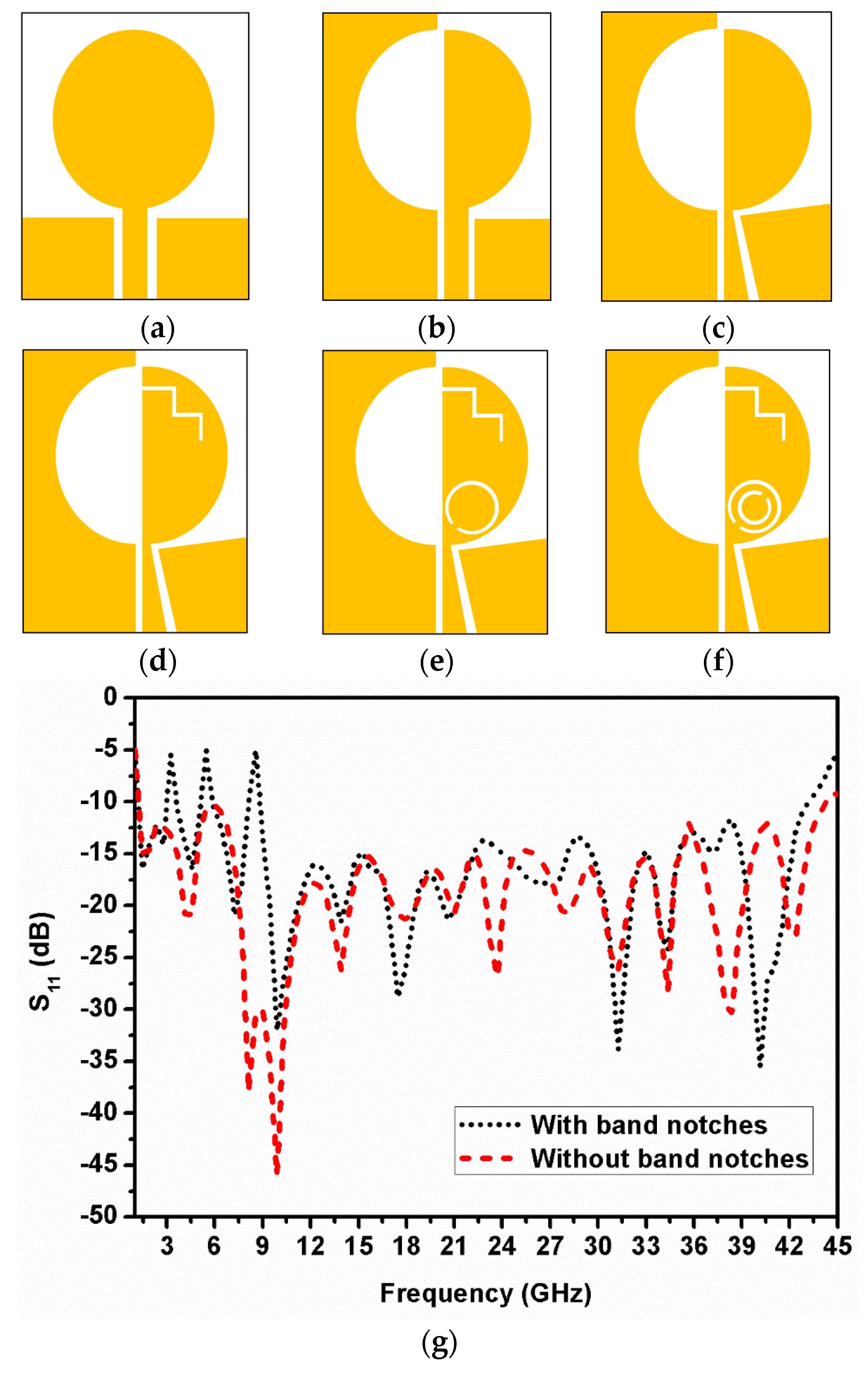
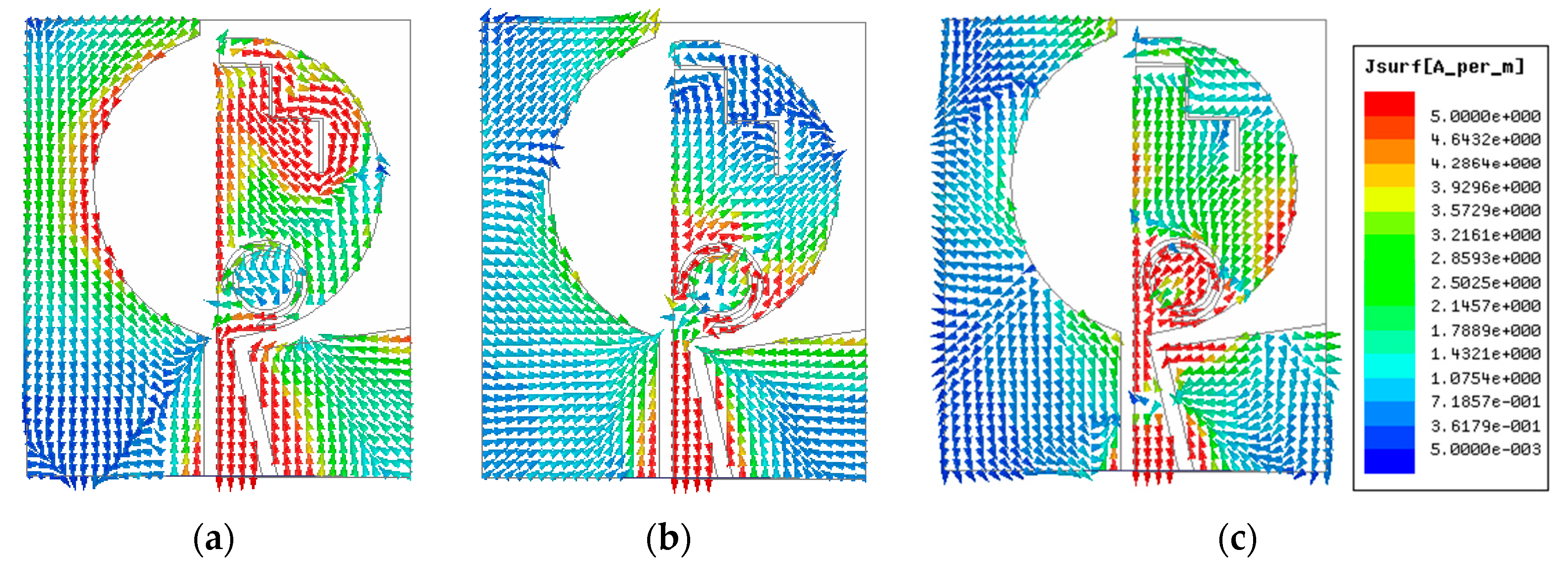

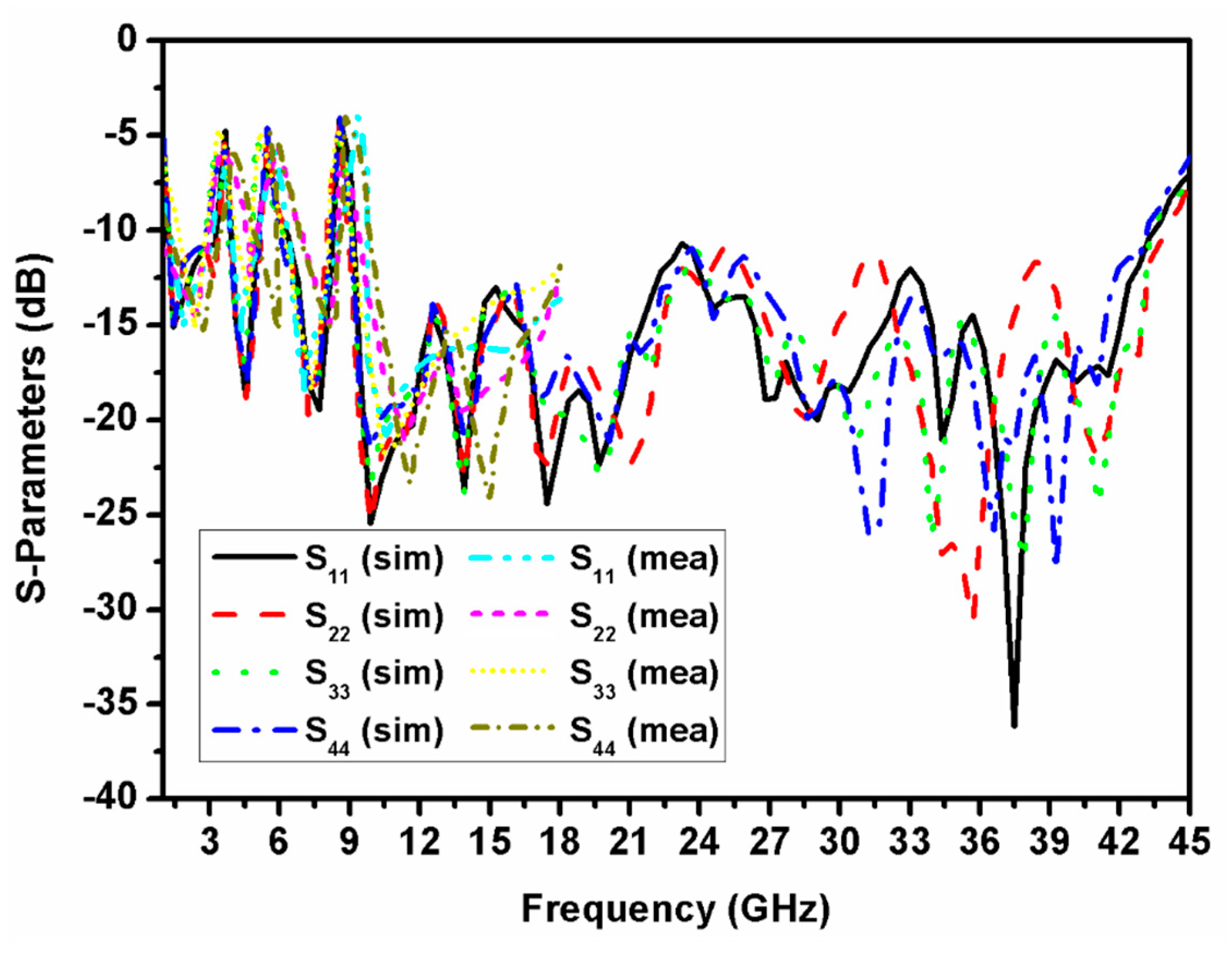

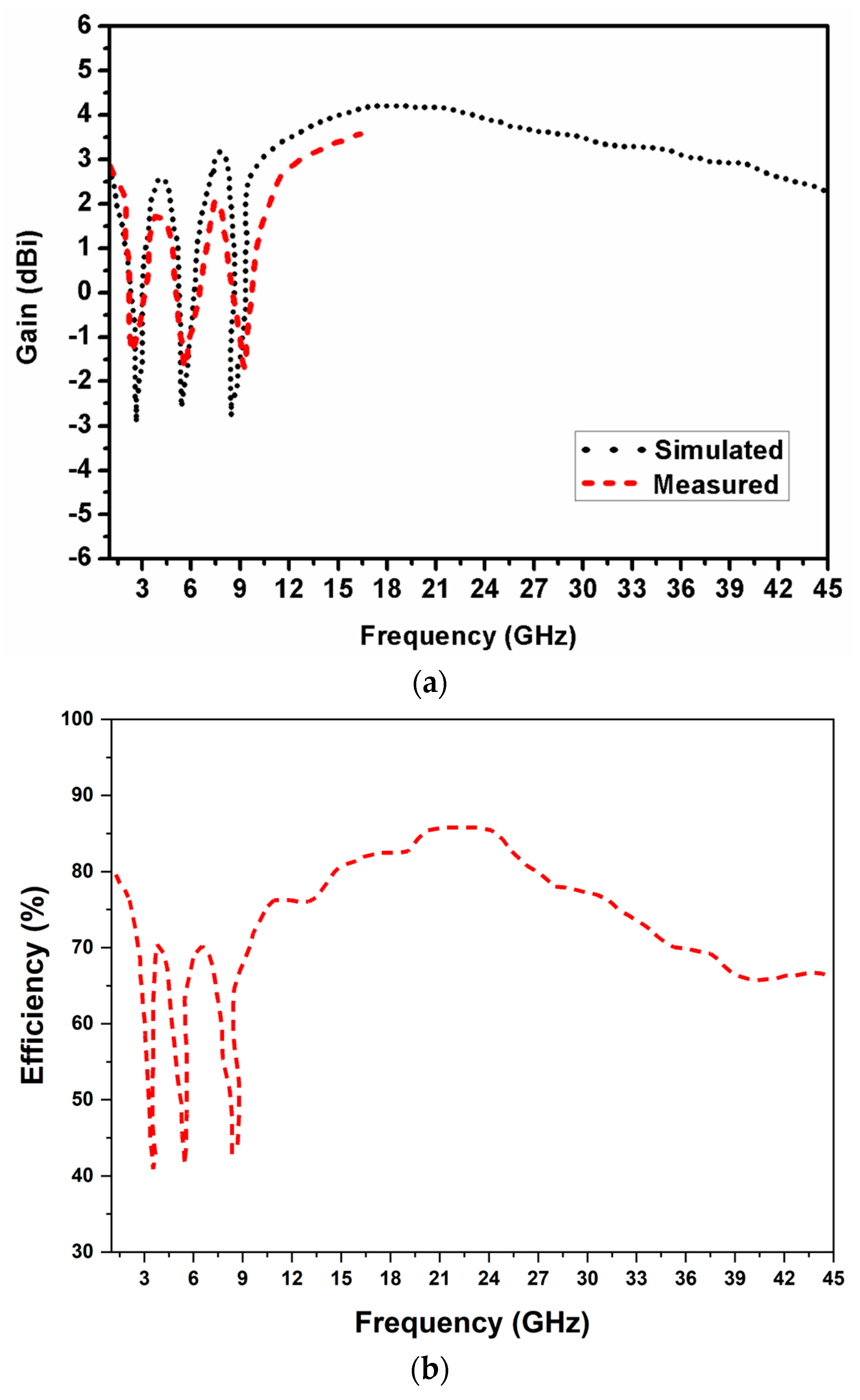
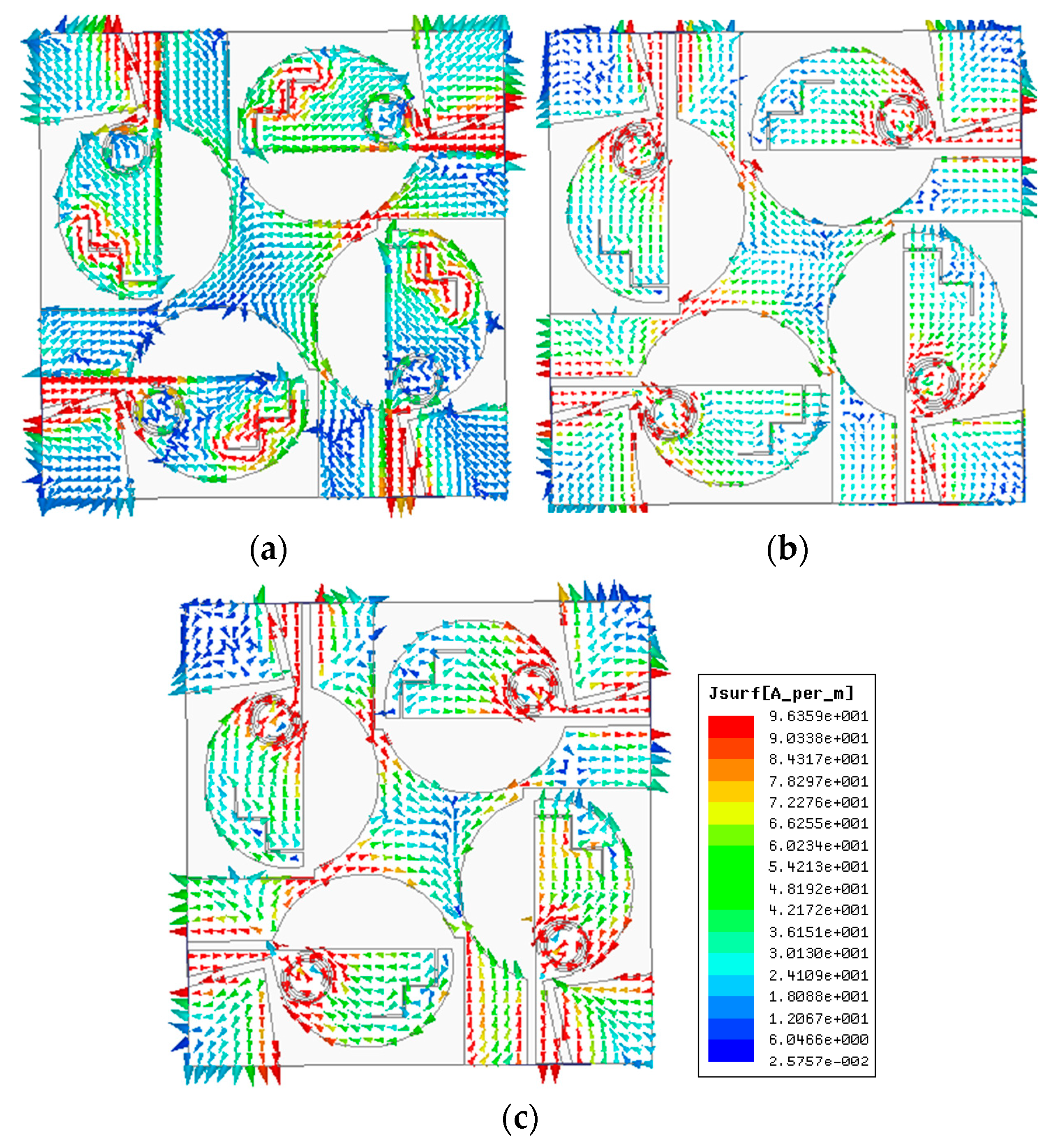
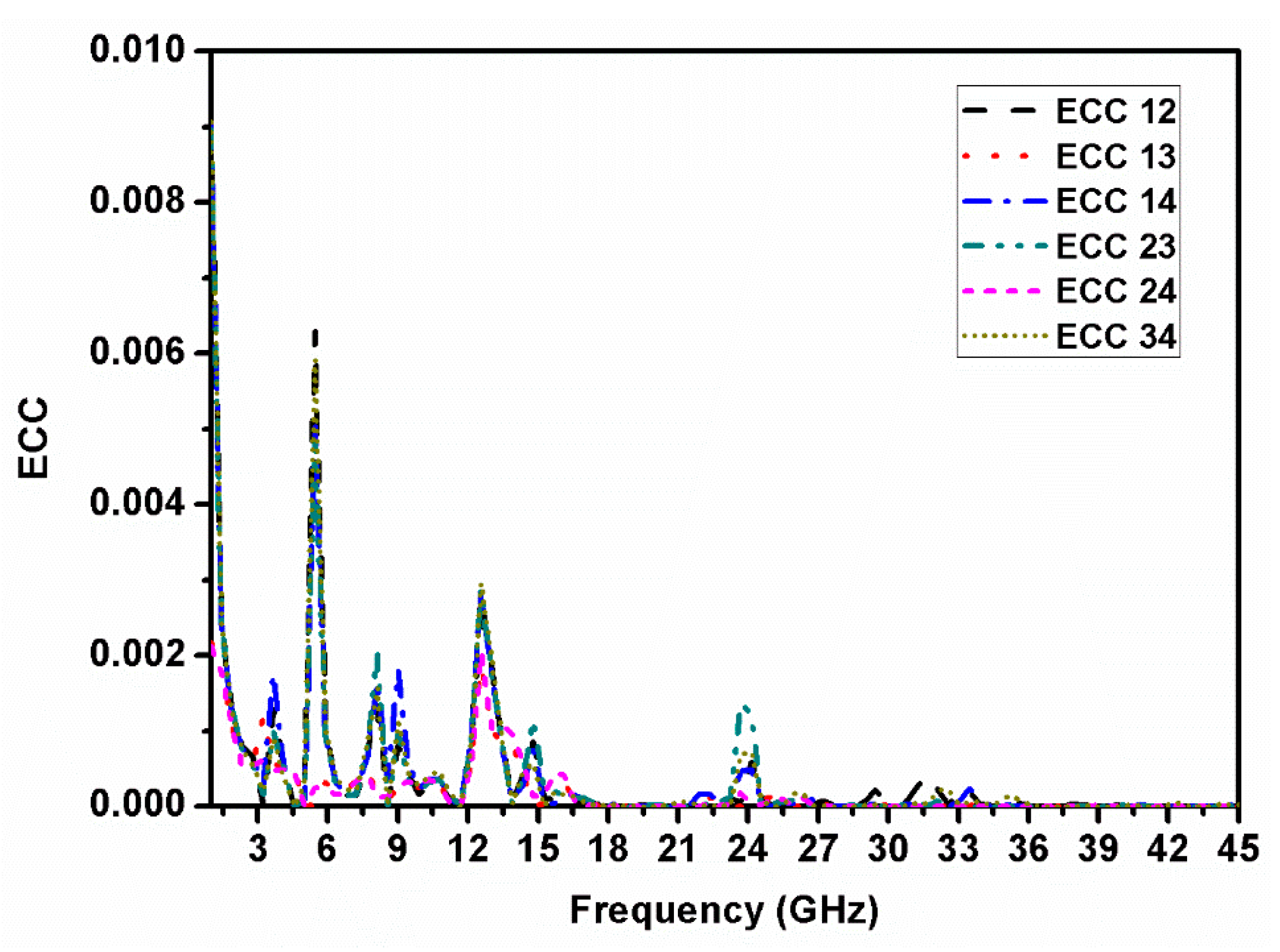
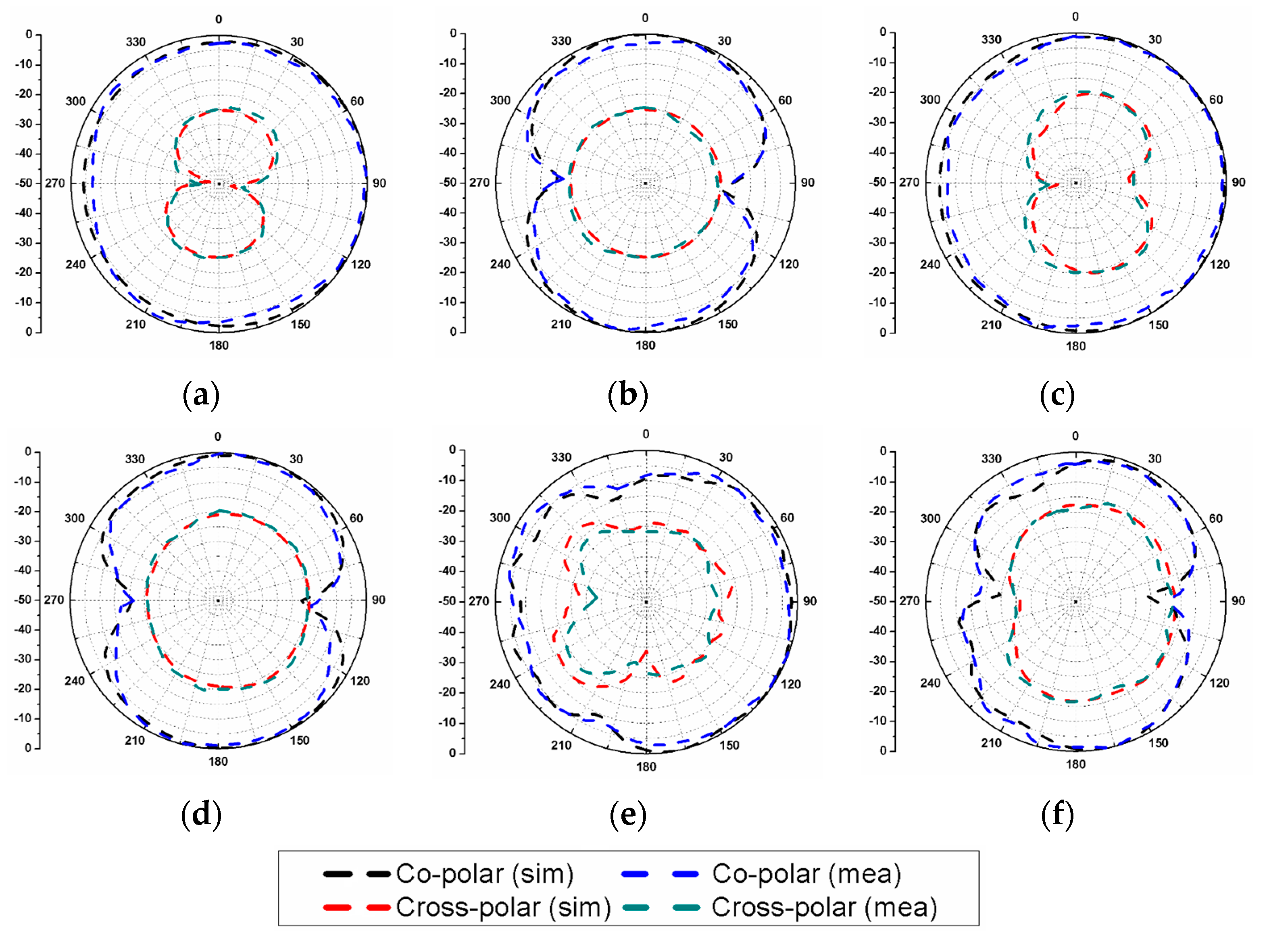
| Ref. | No. of Ports | Antenna Size (mm3) | Impedance Bandwidth (GHz) | Bandwidth Ratio | No. of Notch Bands | Notch Centre Frequency (GHz) | ECC | Isolation (dB) |
|---|---|---|---|---|---|---|---|---|
| [27] | 2 | 21 × 38 × 1.6 | 3–12 | 4:1 | --- | --- | <0.15 | >15 |
| [28] | 2 | 41 × 30 × 1 | 2.19–11.07 | 5:1 | --- | --- | <0.1 | >20 |
| [29] | 2 | 66.8 × 40 × 0.8 | 2.6–13 | 5:1 | 2 | 3.5, 5.5 | <0.02 | >15 |
| [30] | 2 | 130 × 120 × 0.787 | 1.04–27.2 | 26:1 | --- | --- | <−10 dB | >10 |
| [31] | 2 | 38.5 × 38.5 × 1.6 | 3.1–10.6 | 3.4:1 | 3 | 3.7, 4.1, 5.8 | <0.047 | >17 |
| [32] | 4 | 60 × 60 × 1.6 | 3–16.2 | 5.4:1 | 1 | 4.6 | <0.3 | >17.5 |
| [33] | 4 | 100 × 100 × 1.6 | 2–15 | 7.5:1 | 2 | 3.5, 5.5 | <0.1 | >20 |
| [34] | 4 | 81 × 87 × 1.6 | 0.76–1.02, 3.01–12.5 | 4.2:1 | 2 | 4.8, 7.7 | <0.1 | >20 |
| [35] | 2 | 31 × 31 × 1.6 | 3.8–51.5 | 13.5:1 | --- | --- | <−30 | >15 |
| [36] | 2 | 23.5 × 35 × 1 | 1.78–30 | 16.8:1 | --- | --- | <0.1 | >22 |
| [37] | 2 | 55.6 × 50.5 × 1.6 | 1.5–40 | 27:1 | 1 | 5.9–7.1 | <0.005 | >20 |
| [38] | 4 | 58 × 58 × 1 | 2.9–40 | 13.8:1 | --- | --- | <0.04 | >17 |
| [39] | 4 | 60 × 54 × 1.2 | 2.3–23 | 10:1 | --- | --- | <0.002 | >20 |
| [40] | 4 | 37.5 × 37.5 × 1.6 | 4–51.2 | 12.8:1 | --- | --- | <0.01 | >20 |
| [41] | 4 | 52 × 52 × 1.6 | 3.6–18 | 5:1 | --- | --- | <0.005 | >15 |
| This work | 4 | 52 × 52 × 1.6 | 1.2–43 | 36:1 | 3 | 3.5, 5.5, 8.5 | <0.01 | >18 |
| Dimension | [mm] | Dimension | [mm] | Dimension | [mm] |
|---|---|---|---|---|---|
| A1 | 10.2 | L4 | 3.4 | R1 | 2.55 |
| B1 | 7.7 | Wa | 0.25 | R2 | 1.85 |
| A2 | 10.2 | Wb | 0.35 | Y1 | 31 |
| B2 | 9.8 | Wc | 0.35 | Y2 | 19.75 |
| Cx | 16.2 | X1 | 26 | Y3 | 9.5 |
| Cy | 13.2 | X2 | 12 | Y4 | 8.5 |
| G1 | 2.5 | X3 | 9 | Y5 | 10 |
| G2 | 1.5 | X4 | 11.5 | Y6 | 3 |
| L1 | 3.8 | X5 | 11.7 | Y7 | 52 |
| L2 | 3.5 | X6 | 13 | ||
| L3 | 3.4 | X7 | 52 |
Disclaimer/Publisher’s Note: The statements, opinions and data contained in all publications are solely those of the individual author(s) and contributor(s) and not of MDPI and/or the editor(s). MDPI and/or the editor(s) disclaim responsibility for any injury to people or property resulting from any ideas, methods, instructions or products referred to in the content. |
© 2023 by the authors. Licensee MDPI, Basel, Switzerland. This article is an open access article distributed under the terms and conditions of the Creative Commons Attribution (CC BY) license (https://creativecommons.org/licenses/by/4.0/).
Share and Cite
Kumar, S.; Raheja, D.K.; Palaniswamy, S.K.; Kanaujia, B.K.; Mostafa, H.; Choi, H.C.; Kim, K.W. Design and Implementation of a Planar MIMO Antenna for Spectrum-Sensing Applications. Electronics 2023, 12, 3311. https://doi.org/10.3390/electronics12153311
Kumar S, Raheja DK, Palaniswamy SK, Kanaujia BK, Mostafa H, Choi HC, Kim KW. Design and Implementation of a Planar MIMO Antenna for Spectrum-Sensing Applications. Electronics. 2023; 12(15):3311. https://doi.org/10.3390/electronics12153311
Chicago/Turabian StyleKumar, Sachin, Dinesh Kumar Raheja, Sandeep Kumar Palaniswamy, Binod Kumar Kanaujia, Hala Mostafa, Hyun Chul Choi, and Kang Wook Kim. 2023. "Design and Implementation of a Planar MIMO Antenna for Spectrum-Sensing Applications" Electronics 12, no. 15: 3311. https://doi.org/10.3390/electronics12153311





